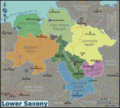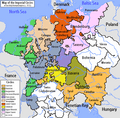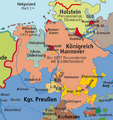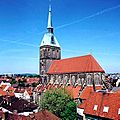Lower Saxony facts for kids
Quick facts for kids
Lower Saxony
Niedersachsen
|
|||
|---|---|---|---|
|
|||
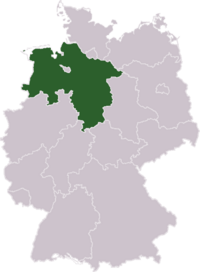 |
|||
| Country | Germany | ||
| Capital | Hanover | ||
| Area | |||
| • Total | 47,168 km2 (18,212 sq mi) | ||
| Population | |||
| • Total | 8,002,916 | ||
| • Density | 169.6683/km2 (439.439/sq mi) | ||
| Time zone | UTC+1 (CET) | ||
| • Summer (DST) | UTC+2 (CEST) | ||
| Website | niedersachsen.de | ||
Lower Saxony (German: Niedersachsen) is a large German state located in the northwest part of the country. It's known for its diverse landscapes, from the flat coastal areas near the North Sea to the hills of the Harz mountains. Lower Saxony is a really important state in Germany, with a rich history and many interesting places to explore.
Contents
What is Lower Saxony Like?
Lower Saxony is the second-largest state in Germany by area. It has a population of over 8 million people. The capital city is Hanover, which is a lively and modern city.
The state is home to many different types of scenery. You can find beautiful beaches and islands along the North Sea coast. Inland, there are large forests, rivers, and even mountains. The Harz mountains in the southeast are popular for hiking and winter sports.
Lower Saxony is also important for farming and industry. It produces a lot of food for Germany. Big companies, like the car maker Volkswagen, also have their homes here.
Cities and Districts
The capital city of Lower Saxony is Hanover. It's a big city with lots of history and modern attractions.
Lower Saxony is divided into many smaller areas called districts. There are 38 districts in total. These districts help manage local services and communities.
Besides the regular districts, there are also 8 special urban districts. These are cities that manage themselves, like their own districts. They include:
- Braunschweig (also known as Brunswick)
- Delmenhorst
- Emden
- Oldenburg
- Osnabrück
- Salzgitter
- Wilhelmshaven
- Wolfsburg
Other important towns in Lower Saxony are Göttingen, Hildesheim, and Goslar. Each of these cities has its own unique history and attractions.
A Look at History
Lower Saxony has a long and interesting history. The area was once part of a much older region called the Duchy of Saxony. This duchy was a powerful area in Europe around the year 1000.
Later, in the 16th century, the region was part of larger groups called Imperial circles. These were administrative areas within the Holy Roman Empire. The area of Lower Saxony was mostly within the "Lower Saxon Circle."
In the 19th century, before modern Germany was formed, the area included several different kingdoms and principalities. These included the Kingdom of Hanover, the Duchy of Brunswick, and the Grand Duchy of Oldenburg.
The modern state of Lower Saxony was officially created after World War II. On November 22, 1946, the British military government issued an order to combine several smaller regions into one new state. This order made Lower Saxony the state we know today.
Famous Places and Landmarks
Lower Saxony is home to several places that are recognized for their special importance. Some of these are even listed as UNESCO World Heritage Sites.
One famous site is the Mines of Rammelsberg near Goslar. This is an ancient mine that was used for over 1,000 years! It's a great example of how people mined for valuable metals long ago.
The Historic Town of Goslar itself is also a World Heritage Site. It's a beautiful old town with many well-preserved medieval buildings.
Another amazing site is the Upper Harz Water Regale. This is a system of dams, ditches, and ponds built hundreds of years ago. It was used to power the mines in the Harz mountains. It's a clever example of early engineering.
The Lower Saxony Wadden Sea is a unique natural area along the coast. It's a huge wetland where the tide goes out very far, revealing mudflats. Many birds and marine animals live here, making it a very important ecosystem.
Finally, the Fagus Factory in Alfeld is another World Heritage Site. It's a very early example of modern architecture, designed by the famous architect Walter Gropius. It was built in 1911 and looks very different from older factories.
Images for kids
-
Cuxhaven port
-
Wilhelmshaven with the North Sea
-
The Duchy of Saxony around 1000
-
The Kingdom of Hanover, the Duchy of Brunswick, the Grand Duchy of Oldenburg and the Principality of Schaumburg-Lippe in the 19th century
See also
 In Spanish: Baja Sajonia para niños
In Spanish: Baja Sajonia para niños





